In today’s fast-paced digital world, standing out from a vast and volatile crowd of online merchants can be challenging, to say the least. As search engines become more sophisticated, traditional keyword-based approaches are gradually loosening their grip in favor of a revolutionary concept called semantic search. Departing from traditional keyword-based approaches, semantic search helps search engines understand the true meaning behind users’ queries. It helps them find exactly what they’re looking for in a breeze.
In this article, we will take a deep dive into semantic search, shedding light on its inner workings and its impact on SEO. We’ll also provide some important semantic search strategies that you can use to optimize content according to the evolving search engine landscape.
What is semantics?
Semantics studies the meaning in language, be it words, phrases, or sentences. For example, the word “child” can mean “kid”, “son”, or “daughter”—all these words technically mean a “child” but each has its own subtle shade of meaning.
And while discussing the terminology may seem a bit tedious, the role of semantics in SEO has become very central in recent days.

What is semantic search?
As opposed to lexical search, semantic search is about understanding the meaning of the query instead of simply looking for literal matches.
It means understanding the user intent within a specific context, sorting through hundreds of billions of web pages, and answering the query in the best possible way.
The results of the semantic search bring together the aggregated information from several websites to answer the query in more detail.
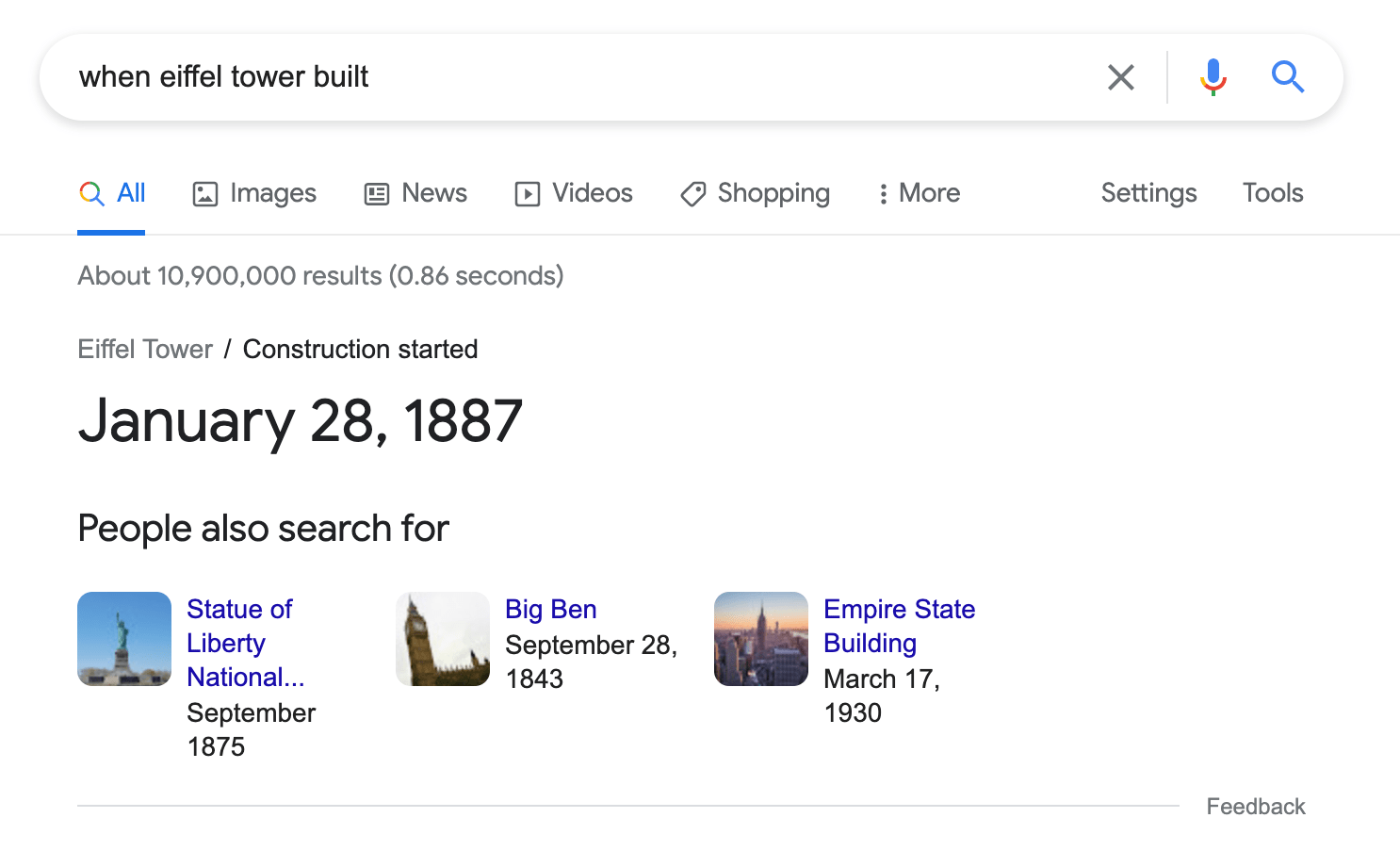
In the example with the Eiffel tower, we get both the correct answer and the information about other popular attractions along with their construction dates.
Due to semantic search, people can type in something specific like “free CMS for the small online shop” or something asked in a natural human language like “what CMS should I use for my website?“—and in each case get satisfactory results.
It’s also important to note that often people use quite broad search queries in the hope of getting specific results. By typing something vague like “free CMS“, users don’t explain whether they are looking for a specific freeware or they simply want to find out if free CMS meets their business goals.
To a human, this request could mean a lot of things, but thanks to algorithms, Google can figure out what results will be more relevant given the context.
How search algorithms work
To meet the highest criteria of quality, Google takes into account numerous factors that eventually determine what you see in search results.
For this, Google created a complex system consisting of many algorithms that crawl, rank, and deliver the relevant pages for a particular query. These algorithms have been undergoing minor and major changes for decades and usually cause a lot of fuss.
Let’s now take a look at the recent core updates that have changed the way the Google algorithm works:
Knowledge Graph
A Knowledge Graph cannot be called an algorithm, but it is still important because it serves as the basis for semantic search.
Google’s Knowledge Graph, which was introduced in May of 2012, serves as a massive knowledge base and graph database that powers the information displayed both in search results and various other Google services.
The primary goal of the Knowledge Graph is to provide users with more meaningful and relevant search results. It accomplishes this by understanding the relationships between different entities and concepts. Instead of simply matching keywords in a search query with web pages, Google’s Knowledge Graph is designed to comprehend the context and intent behind the search, enabling it to offer more precise and direct answers.
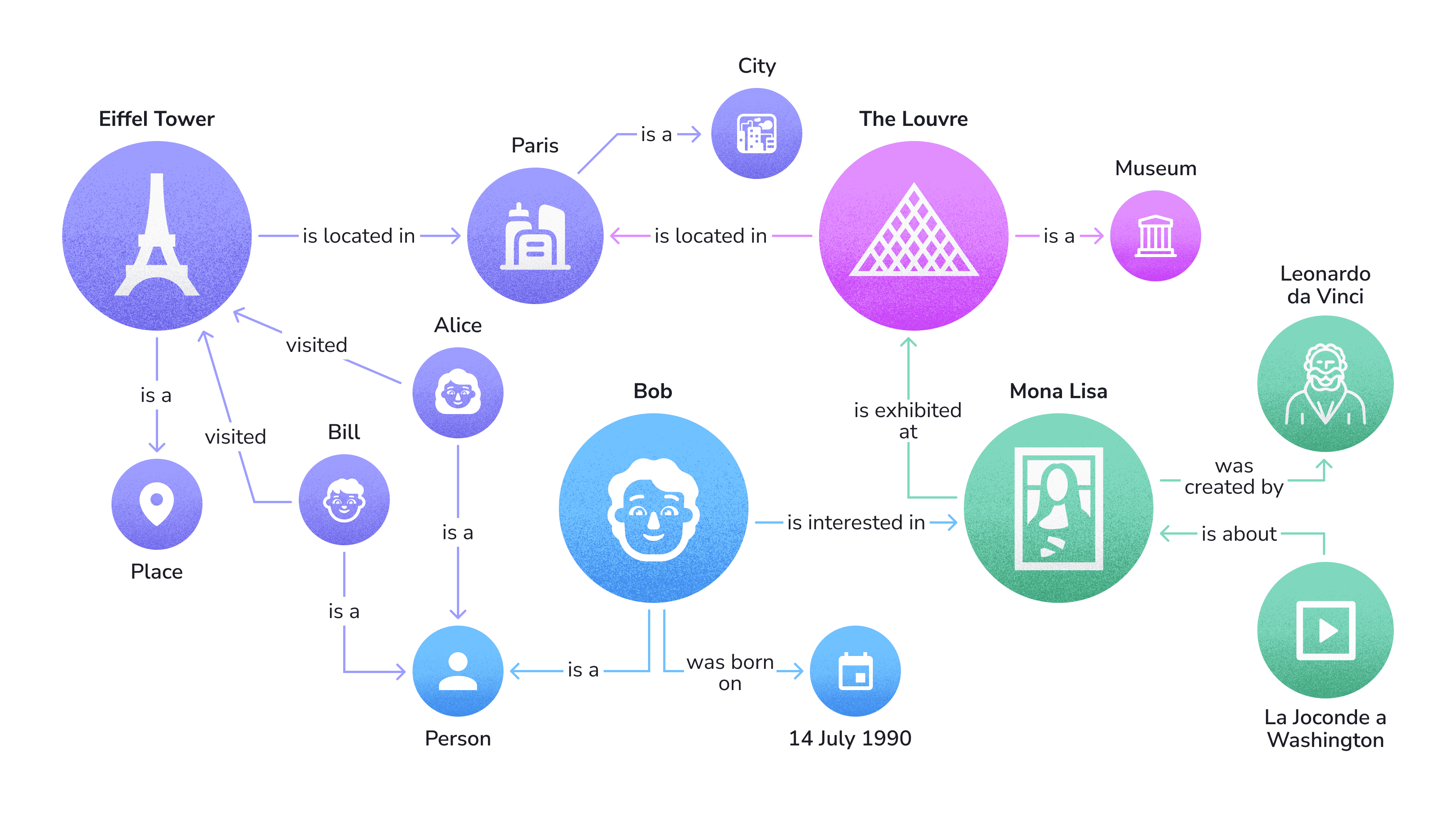
As you can see in the screenshot above, each entity in the Knowledge Graph is associated with various attributes, facts, and contextual information. Google gathers this information from multiple sources, including reputable websites, licensed databases, and other public sources.
By analyzing the connections between entities, the Knowledge Graph can grasp how different entities are related. For example, it can understand the relationships between historical figures, famous landmarks, movies and their actors, and much more.
Google Hummingbird
The introduction of the Hummingbird algorithm update marked a pivotal moment in the evolution of Google’s search engine. Unlike previous updates that focused on individual keywords within a search query, Hummingbird interprets the entire search query as a whole and considers the context and meaning behind it. This means that by implementing the “conversational search” feature, users can get more precise results based on the meaning and intent behind their queries.
Search features that go beyond the blue link
With Hummingbird, Google has sought to provide users with faster and more accurate responses to their queries by better understanding and addressing their intent. In addition to selecting higher-quality pages for search results, the algorithm has made ample use of knowledge graphs, rich results, and featured snippets. This has allowed users to view detailed answers directly on the search surface without the need to click on external links in search results.
BERT
In response to complex and conversational queries, Google introduced another cutting-edge technology known as Bidirectional Encoder Representations from Transformers, or BERT. While the previous update shifted focus to phrase intent analysis, BERT took it a step further by understanding the relationships between words in a query. Google currently has a much deeper understanding of natural human language and can grasp how the meaning of a phrase changes depending on prepositions (like “to” or “for”). This helps search engines process voice inputs more effectively, generating more precise search results based on user intent.
According to Google, 27% of the online global population is using voice search on mobile devices. As more people today use tools like Siri or Google Home, algorithms like BERT are becoming even better at understanding spoken language. And because these kinds of search queries are more conversational and contain longer, more natural phrases, Google uses semantic search’s advanced language processing to provide better voice search results.
Since search requirements are growing in scope and complexity, it is likely that BERT will soon be replaced by a newer model.
MUM (Multitask Unified Model)
To help users with complex queries that cannot be answered directly with a snippet, Google has introduced a new technology called Multitask Unified Model, or MUM.
Let’s take a look at how MUM can help us with complex queries.
Imagine you are planning a trip to a tropical paradise, and when you ask Google for information about the local climate, MUM provides valuable insights. For instance, it could inform you that even though it’s sunny year-round, there is a higher chance of rain during the months of July and August. It might also suggest packing essentials like a compact umbrella or a lightweight raincoat. MUM could even present subtopics for further exploration, such as the best beaches in the area or popular water sports activities. Accompanied by links to relevant articles, videos, and images from various sources on the web, MUM would make trip planning a breeze.
Though this technology is not fully launched yet, and the algorithms are not quite advanced enough to provide immediate answers, Google is working hard to make this a reality very soon. With a tech advancement like this, getting whatever job you need done will be easy.
Bard
Bard is Google’s experimental, conversational AI chat service. It functions similarly to ChatGPT, with the biggest difference being that Google’s free service pulls its information directly from the web. Bard was initially released in a limited capacity in March 2023. Since then, users have been leveraging Bard as a chatbot to answer questions and to help them accomplish various tasks. Here’s a glimpse of what it looks like:
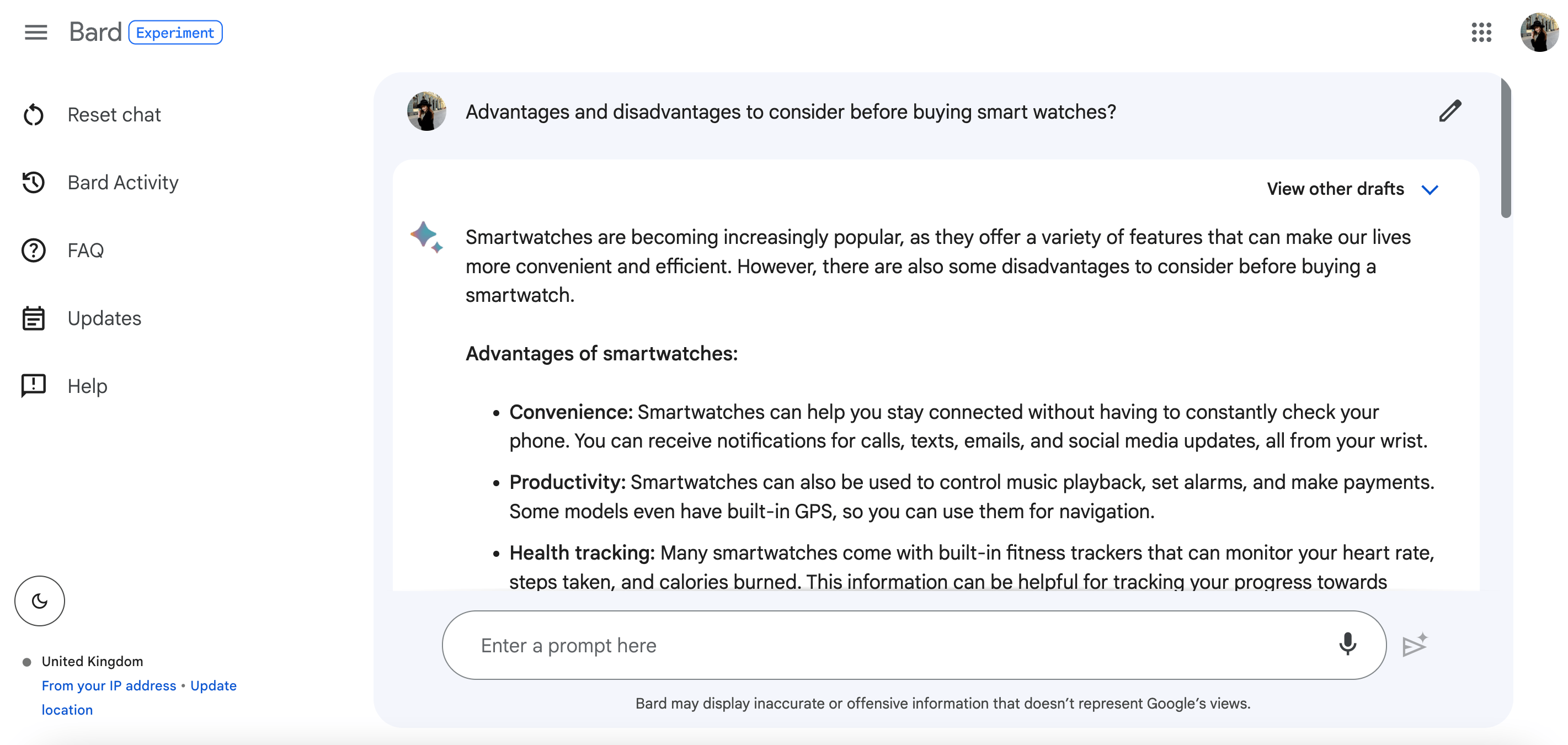
Google plans to integrate Bard into the Knowledge Graph Cards in the not-too-distant future. While the Knowledge Graph currently offers word definitions or overviews of individuals or locations, Bard’s main purpose is to handle questions that do not have a definitive answer.
Bard will soon provide increasingly intricate and context-specific responses to these types of queries.
SGE
Search Generative Experience is the newest Google update. It sought to revolutionize the traditional search experience by incorporating generative AI. SGE generates an interactive AI snippet at the top of the SERP, featuring a verified answer to the query along with links to three or more relevant sources. Users can also ask follow-up questions.
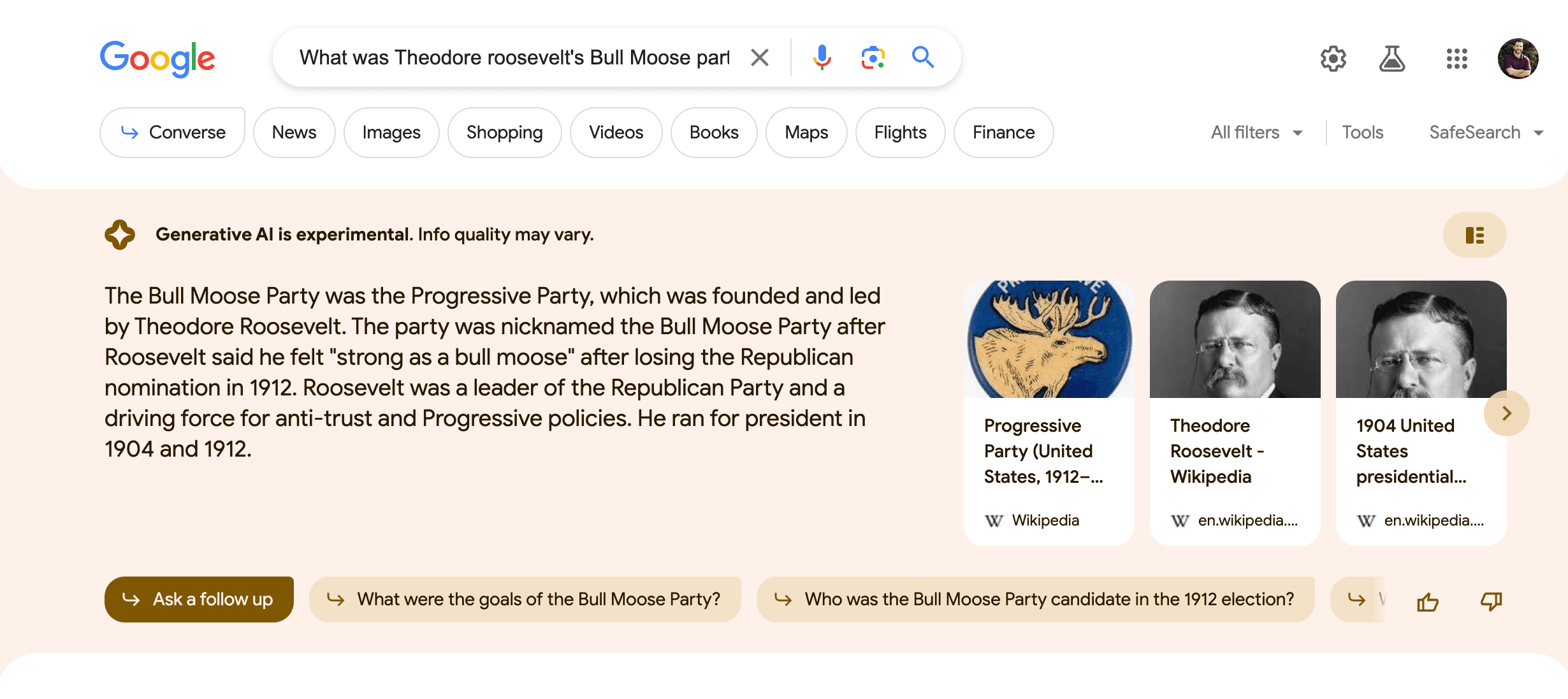
One important thing to note is that the AI snippet selection process is not based on high rankings alone. Instead, SGE prioritizes websites that present the precise angle needed to provide relevant information for the user’s query.
In practical terms, the integration of generative AI in search will help users understand topics faster, uncover new viewpoints and insights, and accomplish tasks more easily.
How Google finds relevant pages
Now, let’s move on to the key criteria that determine what results users see for a particular query.
Meaning of the query
It stands for establishing the intent behind the user request. For this, Google created language ****** to determine what keywords to look up on the web. Such language ****** detect misspelled search queries, understand natural language, match synonyms, and more.
Synonyms
With the synonym system, users are provided with more relevant websites even if they do not contain the exact keywords used in the search.
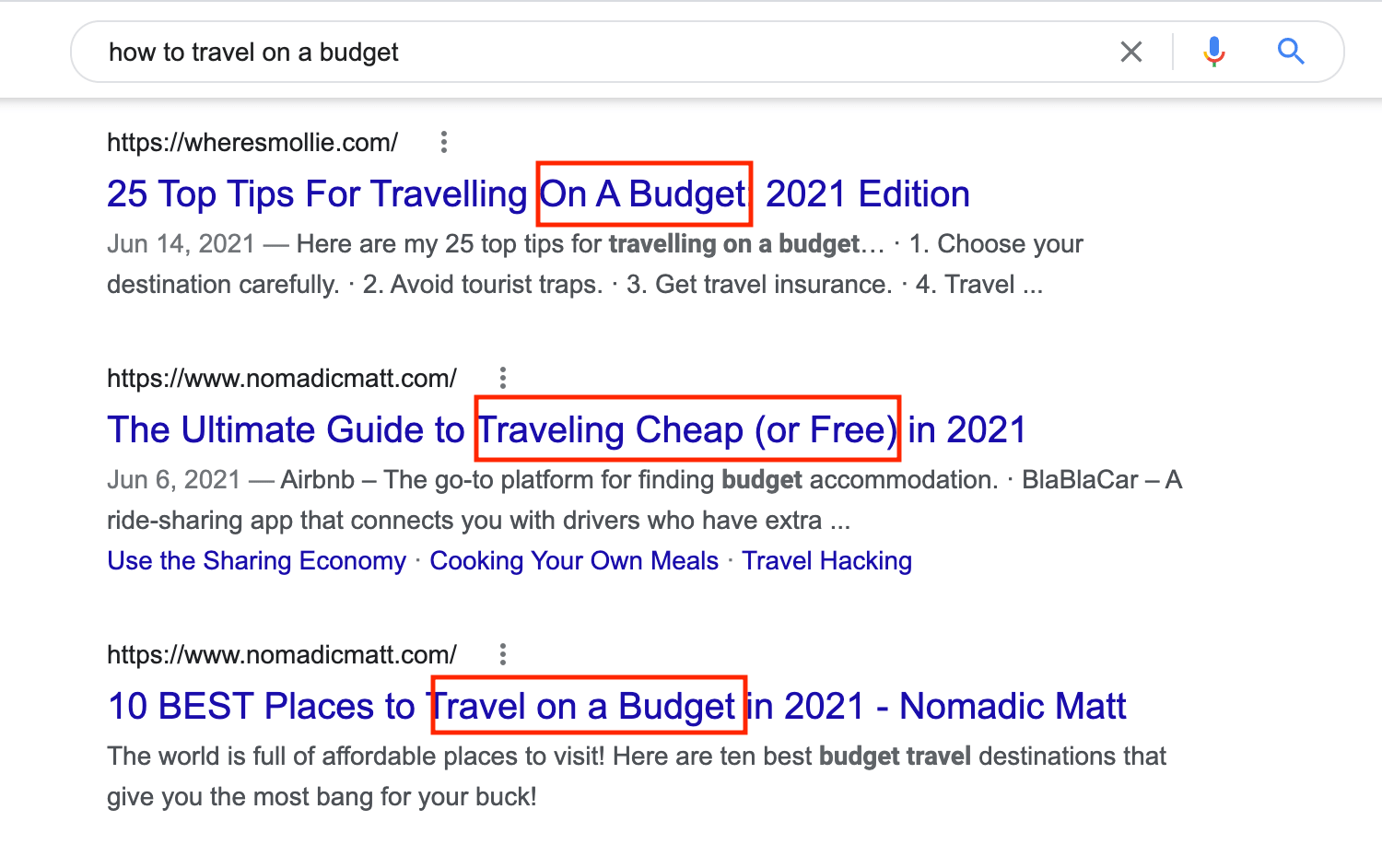
This helps Google match the query “how to travel on a budget” with sources that contain information about budget-friendly flights, cheap hotels, travel insurance, and other helpful tips related to low-cost traveling.
Topical relevance
The second step is to evaluate the content on the web pages and determine whether it is topically relevant or not.
First of all, algorithms analyze keywords: if they appear on a page, headings or the body, this source is more likely to be shown to a user.
Apart from this basic signal, Google evaluates the topical authority of content that includes: in-depth content accompanied by subtopics covering all possible questions, internal linking, and backlinks—that shows how the information meets the search intent.
According to Dixon Jones, an international SEO Speaker and Internet Marketing advisor, just publishing long-form content doesn’t play a key role in earning first-page rankings.

Dixon Jones
International SEO Speaker and Internet Marketing advisor
Semantic SEO is more about tying ideas back to concepts in the search engine’s knowledge graph and connecting these ideas in a tightly themed manner to show a search engine that your content is authoritative when answering the user query. Long-form content can add more relevant topics, but will also broaden the overall topics on the page, which then means the page has a broader appeal, but might not answer well-formed queries by the user.
One of the things that strengthen the relevance of a page is Latent Semantic Indexing (LSI) Keywords, or in other words, supplementary keywords that contribute to the topic.
Let’s take a look at our example about “how to travel on a budget”.
There are hundreds if not thousands of web pages containing information about traveling on a budget. However, not all of them are considered relevant. For instance, if Google sees that the keyphrase “travel on a budget” is repeated over and over again, such a page will unlikely be displayed in search results. On the other hand, when you use LSI keywords (like “low-cost”, “discount”, “cheap”, etc”), Google will be confident that this post is about traveling on a budget.
However, be careful not to overdo it. It may seem right to use as many of them as possible. But that is not a good idea. If you scatter all of them throughout the text, your content may seem spammy to search engines and even lead to penalties.
Craig Campbell, an SEO expert from Glasgow, recommends using semantically related keywords moderately and not overdoing it.

Craig Campbell
International SEO expert
Adding more semantically related keywords does increase your overall keyword count, which will in turn bring more traffic. But it’s important to do so where relevant, I wouldn’t go around sticking in words for the sake of it. If it fits into the article and reads well then why not add it in, especially if it helps the user. But you need to get the balance right, do not overdo it, again there are tools to use to see what the top guys are doing and you can replicate that.
Analyze competitors’ texts with SE Ranking’s Content Editor to outrank them with yours.
How does semantic search impact SEO?
Semantic search has had a significant impact on SEO in recent years. Here’s how:
- Search intent has become a priority: Since search engines are much better at understanding the intent behind a user’s query, websites need to focus on creating content that not only targets specific keywords but also provides valuable information that fulfills user needs. This shift encourages the creation of more relevant and comprehensive content.
- Focus has shifted from keywords to topics. As search engines attempt to understand the context and intent behind a user’s search query, content that covers a topic in-depth and explores related subtopics is more likely to be favored in search results. Prioritize broad topics in your niche that you can cover in-depth to create comprehensive, original, and high-quality resources.
- Featured snippets and rich results currently dominate SERPs: Implementing structured data and schema markup on websites helps search engines better understand the content’s context and organization. This increases your site’s chance of appearing in enhanced search results like rich snippets, knowledge panels, and other visually appealing elements that can attract more clicks.
As you can see, semantic search has shifted the focus of SEO from simple keyword optimization to creating comprehensive, user-centric, and contextually relevant content. Websites that adapt to these changes by producing high-quality, semantically rich content are more likely to benefit from improved search rankings and increased organic traffic.
Utilize SE Ranking’s Search Engine Rank Checker to track your website rankings.
How to optimize your content for semantic search
After taking a good look at the reigning trends of semantic search and its importance for website optimization, now is the time to optimize your site to secure higher rankings on search engines. Here are some key points to pay attention to:
User intent
Research and identify the primary intent behind the keywords you intend to target. Think in terms of what users are looking for when using those search terms. Are they seeking information, looking to make a purchase, or trying to navigate to a specific website?
Focus on topics, not keywords
Creating topic-focused content requires in-depth research and a deep understanding of your audience’s interests and pain points. It involves identifying broad themes or subject areas relevant to your business or website and generating content that covers these topics in-depth. This approach allows content creators to naturally incorporate a variety of related keywords, variations, and semantic terms, making it easier for them to align with how people naturally search for information.
Organize your keywords into topic groups and strategically distribute them across website pages. This creates structured and diverse content that not only appeals to users but also earns priority in search engine rankings, placing your pages at the top of SERPs.
To find all relevant and viral topics for your website, utilize SE Ranking’s Website Keyword Generator. Take a closer look at the Question tab of the Keyword Suggestions section. This is where the tool provides topics that users search for.
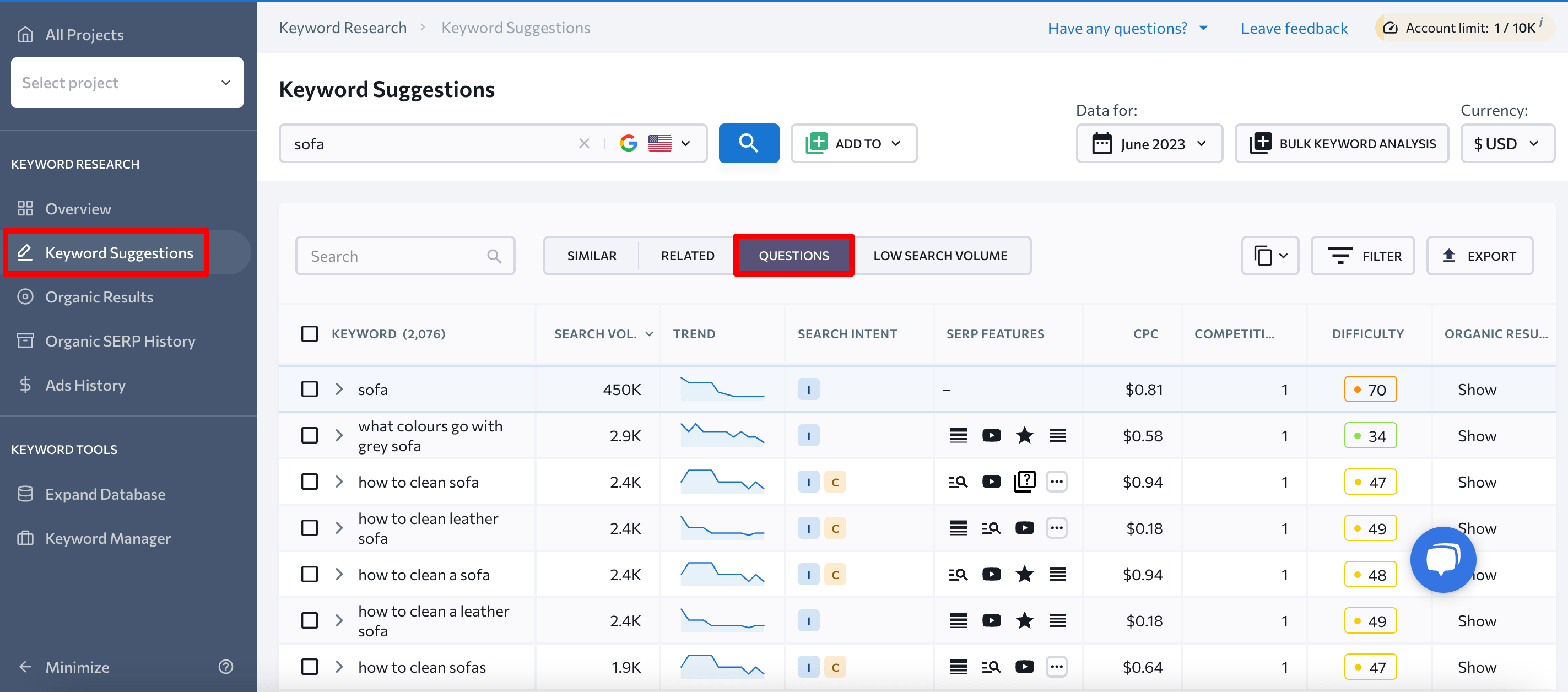
Answer-based content
When writing in-depth, comprehensive articles that cover all aspects of the topic, it’s recommended to focus on answer-based content. Search engines, especially Google, allocate tons of space to featured snippets in search results. Their objective is to quickly provide users with answers to their queries. To maximize your visibility, strive to appear in these featured snippets above the regular organic results.
It’s also important to address common questions and provide thorough explanations. This ensures that users can find all the information they need in one place, minimizing the need to google the same topic further.
Links to showcase relevance
Links remain one of the most important ranking signals. If you want to achieve SEO success, you need to work on backlinks and internal links.
To get high-quality backlinks, prioritize content that naturally attracts links, reach out to websites for guest posting opportunities, and create business profiles and testimonials. To learn more about this topic, read our comprehensive link building guide.
It’s also important to establish a proper internal linking structure to create deep links to valuable content. Work on menu navigation, leverage breadcrumbs, and strategically place links throughout the body of your articles. By linking pages together, you not only help readers navigate your site but also help Google easily crawl it and discover new pages. When setting up internal linking and getting backlinks, ensure your pages contain topical anchor texts.
Structured data
To help Google better understand your content, incorporate structured data, which is specifically designed to categorize the information on a page. Implementing Schema markup provides search engines with information on how to interpret your content, increasing its likelihood of being displayed more attractively in the form of featured or rich snippets.
Semantic HTML
Make use of semantic HTML tags (e.g., <h1> to <h6>, <section>, <header>, etc.) and subheadings when organizing your content. This not only makes your content more readable for users but also helps search engines understand its structure and hierarchy. This can lead to improved search rankings and user experiences. Additionally, assistive technologies, like screen readers, can utilize semantic elements to provide more context and better navigation for users with disabilities.
Conclusion
Semantic search is clearly a game-changer for SEO and online content optimization. What makes it so remarkable is its laser-like focus on what users really want. Search engines have a much better understanding now of what search queries mean and can deliver stunningly accurate results because of it.
This new approach is all about putting users first. Forget about stuffing your content with loads of keywords or dishing out shallow information. Now, it’s all about creating valuable content that people ****.
To rock semantic SEO, you must truly grasp what users are looking for. This means digging deeper into their questions and motivations. Then you have to give them exactly what they want—relevant and rich content that speaks their language and meets their expectations.
